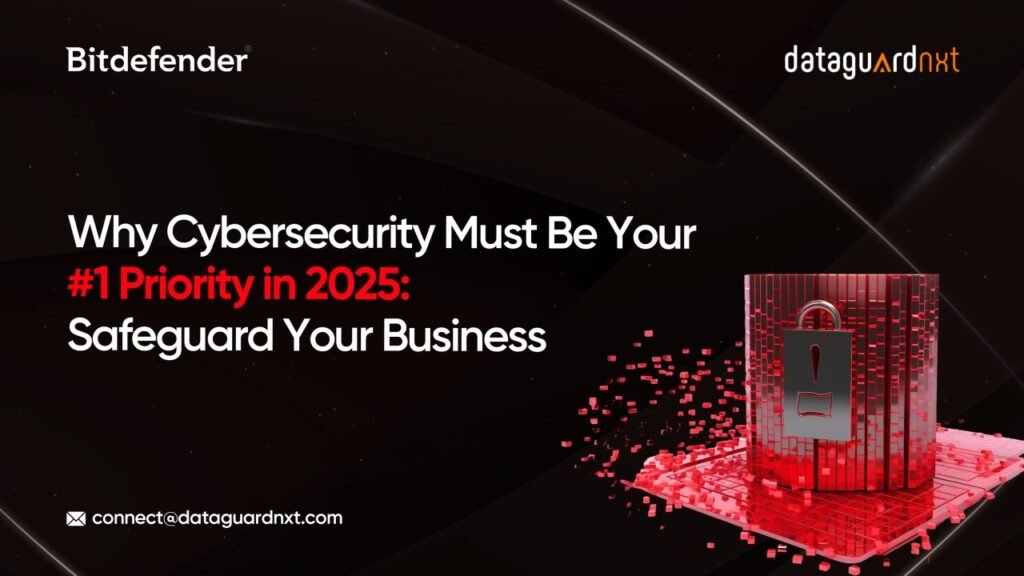Introduction: Entering a New Era of Cyber Threats
As 2025 unfolds, businesses, governments, and individuals are facing one of the most pressing challenges of the digital age: cybersecurity. The accelerated pace of technological innovation—ranging from artificial intelligence (AI) integration to cloud-first infrastructures and the rapid growth of remote and hybrid work—has expanded both opportunities and vulnerabilities. Threat actors are no longer limited to small-time hackers; they now include sophisticated cybercriminal organizations, state-sponsored entities, and opportunistic insiders. The cost of ignoring cybersecurity is rising dramatically, not only in terms of financial losses but also in reputation, customer trust, and even regulatory compliance. Prioritizing cybersecurity in 2025 is no longer optional; it has become an essential pillar of survival and growth in an increasingly hostile digital ecosystem.
The Expanding Cybersecurity Landscape in 2025
The cybersecurity landscape of 2025 looks drastically different from just five years ago. Organizations are grappling with an ever-growing attack surface, accelerated by widespread adoption of cloud solutions, Internet of Things (IoT) devices, and interconnected networks. At the same time, cybercriminals have become more innovative, leveraging automation, AI, and machine learning to bypass traditional defenses. Phishing campaigns have grown more targeted, ransomware has become more devastating, and supply chain attacks have shaken confidence in trusted vendors. Governments around the world are also stepping up with stricter regulations, such as Europe’s GDPR expansions and the United States’ updated cybersecurity mandates for critical infrastructure. This means businesses cannot afford to be reactive; they must adopt proactive, layered security strategies that anticipate threats before they strike.
Why Cybersecurity is Business-Critical in 2025
When evaluating why cybersecurity should be a top priority, it helps to look at the potential consequences of neglect. The financial implications of cyberattacks continue to skyrocket, with the global average cost of a data breach projected to exceed $5 million in 2025, according to industry analysts. More than the direct costs, breaches bring long-term consequences such as customer distrust, lost contracts, and reputational damage that can take years to recover from. Furthermore, the integration of digital services into nearly every industry—from banking to healthcare to manufacturing—means cybersecurity failures now threaten lives, not just ledgers. To put it simply, organizations that underestimate cybersecurity in 2025 risk losing not only revenue but their very existence.
- Data breaches are expected to rise globally by over 20% in 2025.
- The average ransomware demand has exceeded $2 million per incident.
- Over 60% of small businesses close within six months of a major cyberattack.
- Regulatory fines for non-compliance can exceed tens of millions.
- Customer trust remains one of the hardest elements to rebuild after a breach.
The Shift from Perimeter Defense to Zero Trust
Understanding the Zero Trust Model
In the past, organizations relied heavily on perimeter defenses like firewalls, antivirus software, and VPNs. But in 2025, with cloud-based applications, remote workforces, and mobile devices, the perimeter has blurred to the point of near extinction. This is where Zero Trust Architecture (ZTA) has emerged as a fundamental cybersecurity strategy. Rather than assuming that anyone inside a network can be trusted, Zero Trust operates on the principle of “never trust, always verify.” Every user, device, and application must continuously authenticate and validate their identity, no matter their location or level of access.
Why Zero Trust is Essential in 2025
- The adoption of Zero Trust is no longer a trend but a necessity. It reduces the likelihood of insider threats, contains lateral movement within networks, and aligns with regulatory requirements for data protection.
- Organizations that implement Zero Trust strategies gain greater visibility into who is accessing what, minimize potential breaches, and can adapt to rapidly evolving attack vectors with agility.
The Role of Artificial Intelligence in Cybersecurity
Artificial Intelligence is shaping both sides of the cybersecurity battle in 2025. On one hand, attackers are using AI-powered tools to craft convincing phishing campaigns, bypass intrusion detection systems, and automate large-scale attacks. On the other hand, security teams are leveraging AI for anomaly detection, predictive analytics, and automated incident response. AI-based tools can sift through millions of events to identify patterns that humans might miss, thereby reducing detection times from months to minutes. However, reliance on AI comes with its own challenges, including biases in training data and the risk of adversarial AI attacks. The key lies in combining AI-driven tools with human expertise for a balanced and resilient defense posture.
Comparing Cybersecurity Threats: 2020 vs 2025
| Threat Type | Prevalence in 2020 | Prevalence in 2025 | Key Evolution |
| Phishing | High | Very High | More personalized and AI-generated, harder to detect. |
| Ransomware | Medium | Extremely High | Double-extortion methods and ransom demands exceeding millions. |
| Supply Chain Attacks | Low | High | Targeting trusted vendors to infiltrate larger organizations. |
| Insider Threats | Moderate | High | Greater with remote work and cloud misconfigurations. |
| State-Sponsored Attacks | Moderate | Very High | Growing due to geopolitical tensions and cyber warfare strategies. |
Cybersecurity in the Age of Remote and Hybrid Work
The global workforce shift toward remote and hybrid models has permanently changed the cybersecurity landscape. Employees now access sensitive systems from home networks, personal devices, and public Wi-Fi, creating vulnerabilities that did not exist in centralized office setups. Security teams must therefore invest in endpoint protection, multi-factor authentication (MFA), and secure access service edge (SASE) frameworks. Employee training has become equally important, as human error remains one of the leading causes of data breaches. In 2025, the organizations that succeed in securing remote work are those that blend technology with a culture of cybersecurity awareness.
Emerging Regulations and Compliance Pressures
- Another reason cybersecurity is the #1 priority in 2025 is the increasing burden of compliance.
- Regulators across industries are imposing stricter requirements around data privacy, breach notifications, and security frameworks.
- For example, the expansion of GDPR-like laws into countries beyond the European Union has made global compliance more complex.
- In addition, industry-specific regulations—such as HIPAA for healthcare or PCI DSS for finance—demand constant updates. Failure to comply doesn’t just invite fines but also erodes trust among stakeholders. Businesses must integrate compliance into their cybersecurity strategies, ensuring that policies, audits, and monitoring systems align with evolving legal requirements.
Table: Top Cybersecurity Investments in 2025
| Investment Area | Purpose | Business Benefit |
| Zero Trust Architecture | Eliminate implicit trust in networks | Reduce insider and lateral movement risks |
| AI-Powered Security Tools | Automate threat detection and response | Faster mitigation, reduced human workload |
| Cloud Security Platforms | Protect multi-cloud and hybrid infrastructures | Maintain compliance and secure scalability |
| Endpoint Protection | Secure devices in remote/hybrid environments | Lower data breach risks |
| Employee Awareness Training | Educate staff to identify and prevent cyber threats | Strengthen human firewall |
Practical Steps to Strengthen Cybersecurity in 2025
Building a Culture of Security
Technical solutions alone are insufficient without a strong culture of cybersecurity awareness. Organizations should implement regular employee training, phishing simulations, and security drills to ensure staff members remain vigilant. Leaders must also make cybersecurity a boardroom priority, integrating it into business strategy rather than treating it as an afterthought.
Adopting Layered Security Strategies
Layered defenses are key to minimizing risk in 2025. This means combining multiple protective measures, including firewalls, intrusion detection systems, MFA, data encryption, and real-time monitoring. By layering defenses, businesses can ensure that even if one measure fails, others can prevent or limit the impact of an attack.
Investing in Incident Response and Recovery Plans
Preparedness is everything in cybersecurity. An incident response plan (IRP) outlines how an organization will detect, contain, eradicate, and recover from a cyberattack. Without such a plan, even small incidents can spiral into catastrophic breaches. Regularly testing and updating the IRP ensures resilience and business continuity.
Conclusion: Cybersecurity as the Foundation of Digital Trust
In 2025, making cybersecurity your #1 priority is not about fear—it is about foresight. Every industry, every business, and every individual connected to the digital world must recognize that security is the foundation of digital trust. Without robust cybersecurity, growth, innovation, and digital transformation cannot be sustained. By embracing Zero Trust principles, leveraging AI responsibly, complying with regulations, and building a culture of security, organizations can protect themselves against evolving threats and position themselves as trusted leaders in the digital economy. The future belongs to those who treat cybersecurity not as a cost but as a cornerstone of success.
Frequently Asked Questions (FAQs)
1. Why is cybersecurity more important in 2025 than before?
Because the attack surface has expanded due to cloud adoption, AI-driven attacks, and remote work, making organizations more vulnerable.
2. What industries are most at risk of cyberattacks in 2025?
Healthcare, finance, government, and manufacturing remain top targets due to sensitive data and critical operations.
3. How does Zero Trust help protect businesses?
Zero Trust eliminates implicit trust, requiring constant verification for all users, devices, and applications.
4. What role does AI play in cybersecurity?
AI enhances threat detection and response but also enables attackers to launch more sophisticated attacks.
5. How expensive can a cyberattack be for a business?
The average breach in 2025 can cost over $5 million, not including reputational losses.
6. How can remote workers stay secure?
Using VPNs, MFA, endpoint protection, and avoiding unsecured Wi-Fi can greatly reduce risks.
7. Are small businesses really targets of cybercrime?
Yes, over 60% of small businesses face cyberattacks, and many cannot recover afterward.
8. What is the role of employee training in cybersecurity?
It strengthens the “human firewall,” helping employees recognize and prevent threats like phishing.
9. How do regulations affect cybersecurity strategies?
Organizations must comply with stricter data protection laws or risk fines and reputational damage.
10. What’s the most practical first step to improve cybersecurity in 2025?
Conducting a comprehensive risk assessment and developing an actionable cybersecurity roadmap.


